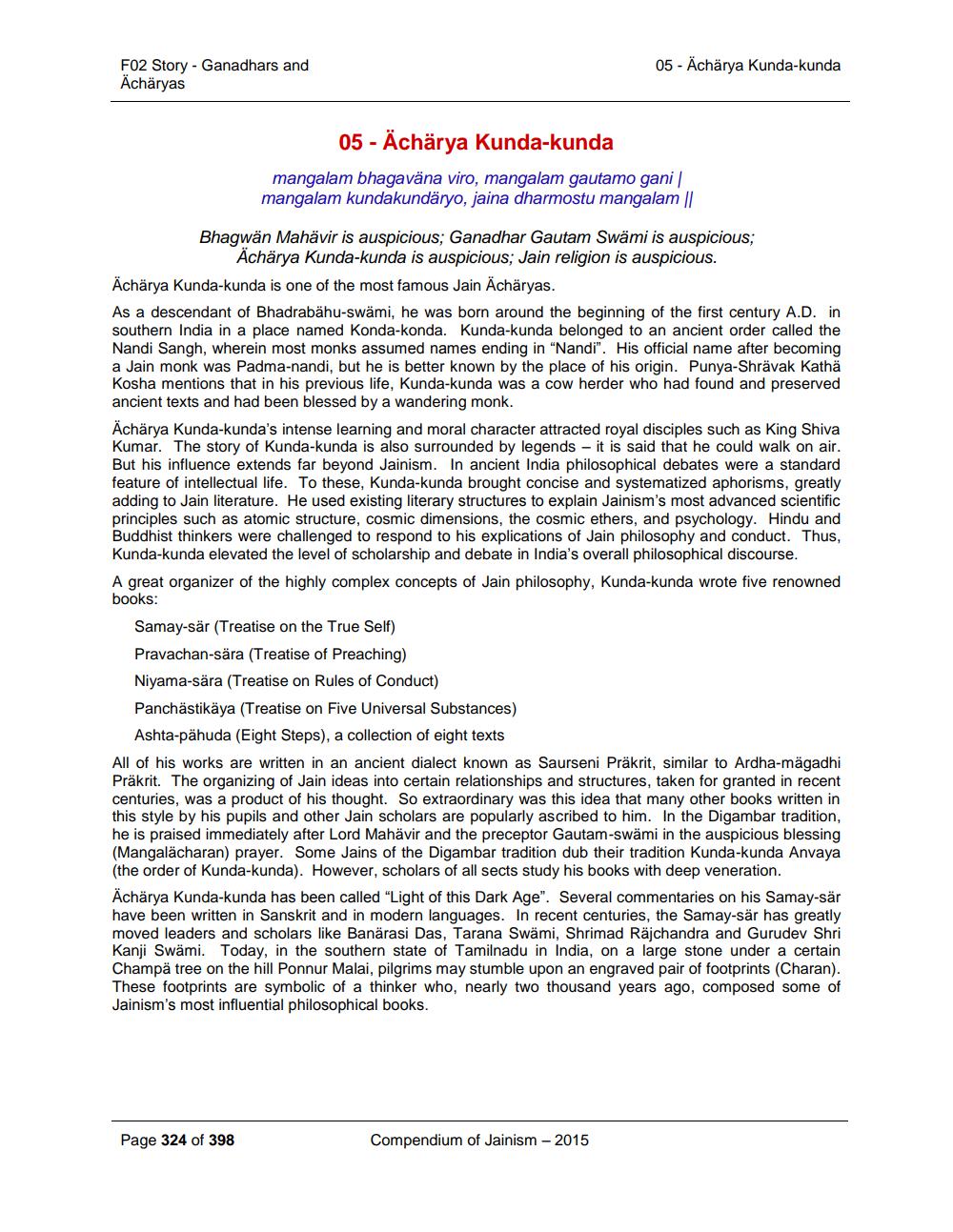________________
F02 Story - Ganadhars and Acharyas
05 - Ächärya Kunda-kunda
mangalam bhagavana viro, mangalam gautamo gani | mangalam kundakundäryo, jaina dharmostu mangalam ||
Bhagwan Mahavir is auspicious; Ganadhar Gautam Swami is auspicious; Acharya Kunda-kunda is auspicious; Jain religion is auspicious.
Ächärya Kunda-kunda is one of the most famous Jain Ächäryas.
As a descendant of Bhadrabähu-swämi, he was born around the beginning of the first century A.D. in southern India in a place named Konda-konda. Kunda-kunda belonged to an ancient order called the Nandi Sangh, wherein most monks assumed names ending in "Nandi". His official name after becoming a Jain monk was Padma-nandi, but he is better known by the place of his origin. Punya-Shrävak Kathä Kosha mentions that in his previous life, Kunda-kunda was a cow herder who had found and preserved ancient texts and had been blessed by a wandering monk.
05 - Ächärya Kunda-kunda
Ächärya Kunda-kunda's intense learning and moral character attracted royal disciples such as King Shiva Kumar. The story of Kunda-kunda is also surrounded by legends - it is said that he could walk on air. But his influence extends far beyond Jainism. In ancient India philosophical debates were a standard feature of intellectual life. To these, Kunda-kunda brought concise and systematized aphorisms, greatly adding to Jain literature. He used existing literary structures to explain Jainism's most advanced scientific principles such as atomic structure, cosmic dimensions, the cosmic ethers, and psychology. Hindu and Buddhist thinkers were challenged to respond to his explications of Jain philosophy and conduct. Thus, Kunda-kunda elevated the level of scholarship and debate in India's overall philosophical discourse.
A great organizer of the highly complex concepts of Jain philosophy, Kunda-kunda wrote five renowned books:
Samay-sär (Treatise on the True Self)
Pravachan-sära (Treatise of Preaching)
Niyama-sära (Treatise on Rules of Conduct)
Panchästikäya (Treatise on Five Universal Substances)
Ashta-pähuda (Eight Steps), a collection of eight texts
All of his works are written in an ancient dialect known as Saurseni Präkrit, similar to Ardha-mägadhi Präkrit. The organizing of Jain ideas into certain relationships and structures, taken for granted in recent centuries, was a product of his thought. So extraordinary was this idea that many other books written in this style by his pupils and other Jain scholars are popularly ascribed to him. In the Digambar tradition, he is praised immediately after Lord Mahävir and the preceptor Gautam-swämi in the auspicious blessing (Mangalächaran) prayer. Some Jains of the Digambar tradition dub their tradition Kunda-kunda Anvaya (the order of Kunda-kunda). However, scholars of all sects study his books with deep veneration.
Page 324 of 398
Ächärya Kunda-kunda has been called "Light of this Dark Age". Several commentaries on his Samay-sär have been written in Sanskrit and in modern languages. In recent centuries, the Samay-sär has greatly moved leaders and scholars like Banärasi Das, Tarana Swämi, Shrimad Räjchandra and Gurudev Shri Kanji Swami. Today, in the southern state of Tamilnadu in India, on a large stone under a certain Champä tree on the hill Ponnur Malai, pilgrims may stumble upon an engraved pair of footprints (Charan). These footprints are symbolic of a thinker who, nearly two thousand years ago, composed some of Jainism's most influential philosophical books.
Compendium of Jainism - 2015




